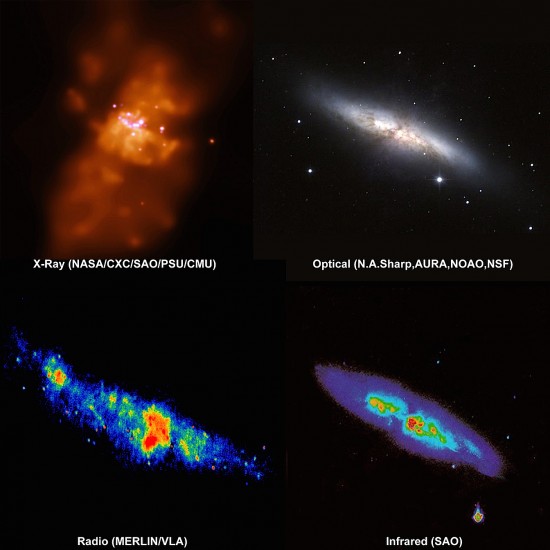Dec 22, 2015
Something near M82 started sending out powerful radio waves more than five years ago and has been holding steady ever since.
Energy emissions in radio wavelengths are shining from somewhere near galaxy M82, otherwise known as the Cigar Galaxy. The fact that nothing like them had ever been seen before created a stir among astrophysicists when they were first detected.
A team of astrophysicists believe that the radio source could be a large black hole pulling matter into an accretion disk, where it is being accelerated to high velocities. Perhaps the strangest aspect to the phenomenon is that it appears to be moving across the sky at four times the speed of light. Astronomers do not think that the apparent motion really exceeds light speed, but that it is moving almost as fast as light at a particular angle creating an optical illusion. Some “matter jets” shooting out of active galactic nuclei also seem to travel faster than light.
An electric current in plasma generates a magnetic field that will constrict the current flow. As has been pointed out in previous Picture of the Day articles, the constricted channel is known as a Bennett pinch, or z-pinch. The “pinched” filaments of electric current remain coherent over large distances, spiraling around each other, forming helical structures that can transmit power through space.
Plasma physicists identify those threads of electricity in almost every body in the Universe. The cometary “tail” of Venus is “stringy” as NASA scientists describe it. The glow of planetary nebulae resolve into strings and intricate webs. Herbig-Haro stars and some galaxies often reveal braided filaments. These filaments are Birkeland currents, and they are only the visible portions of enormous electric circuits. The remainder of the galactic circuit generates magnetic fields that can be mapped, as in the case of M82.
High-density currents flow out along the galactic spin axis and form double layers that can sometimes be seen as radio and X-ray lobes around active galaxies. The currents then spread out around the circumference, returning to the core along the spiral arms. Every element in a galactic circuit radiates energy, indicating that they are powered through coupling with larger circuits. Galaxies appear to occur in strings, so the extent of the larger circuits can be inferred.
Plasma’s behavior is driven by conditions in those circuits. Fluctuations can form double layers with large potential voltages between them. The electric forces in double layers can be much stronger than gravitational and mechanical forces. Double layers separate plasma into cells and filaments that can have different temperatures or densities.
Double layers emit radio waves over a broad band of frequencies. They can sort galactic material into regions of like composition and condense it. They can accelerate charged particles to cosmic ray energies. Double layers can explode, releasing more energy than is locally present. This effect can be seen in stellar flares or so-called “nova” outbursts.
This vision of the cosmos sees various components coupled to and driven by circuits at ever larger scales. Electrons and other charged particles accelerating through intense electric fields radiate energy in many bandwidths. Changing conditions within the Birkeland current generators of some galaxies means that the radiation patterns will change over time. M82 is probably demonstrating those changing conditions in a years long display of electricity in action.
Stephen Smith













